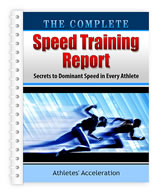'A' SKIP DRILLGenerally, athletes are so bad at this drill (I don't want to admit how long it took me to learn this drill correctly) that I only let them perform it with one leg at a time, in place and, of course, with no arms. Like with the A - MARCH, teach this drill with no arms at first. For the sake of political correctness, I won't make an analogy as to what your team will look like if they try to do the full drill right away. Most of your athletes will just turn this into a regular, exaggerated skip. That's why I start them in place. But the key to the 'A' SKIP is the double hop on the support leg. Each hop should only be a couple of inches off the ground, but there should be two of them: the first as the active leg recovers and active ankle steps over the knee and the second as the active leg is decelerated into the ground. When done correctly, both feet should hit the ground at the same time.
'A' SKIP (no arms, alternating legs, in place)
In writing it doesn't look much different than the 'A' MARCH but it is. Once athletes can coordinate the double hop you can let them cover some ground, add arm action and alternate legs. The next drill to teach is the 'A' RUN. This drill starts to simulate running mechanics in a more obvious way than the other drills, though it can be just as difficult to learn. Click Here to Go Back to the
Related Articles: Speed Training Drills | Speed Training: Arm Action Drill | Warm up Drills | 3 Speed Drills You Should Never Use | 'A' March Drill | 'A' Skip Drill | 'A' Run Speed Drill | Fast Leg Drill | Sprinting - Mechanical problems | Dynamic Warm-up Speed Drill
|
|||||
